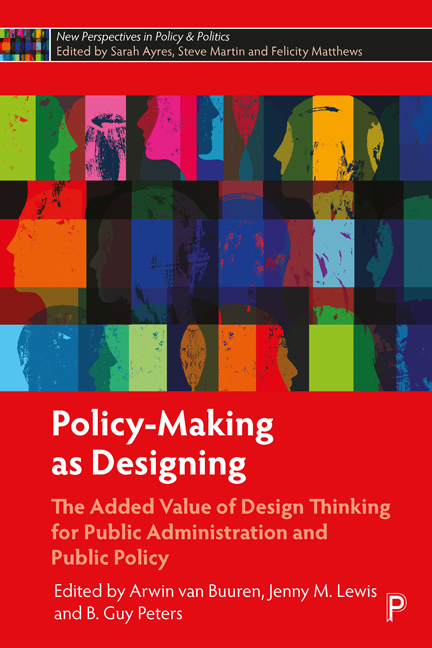 Policy-Making as Designing
Policy-Making as Designing Book contents
- Frontmatter
- Contents
- List of figures and tables
- Notes on contributors
- 1 Improving public policy and administration: exploring the potential of design
- 2 Applying design in public administration: a literature review to explore the state of the art
- 3 Challenges in applying design thinking to public policy: dealing with the varieties of policy formulation and their vicissitudes
- 4 Designing environments for experimentation, learning and innovation in public policy and governance
- 5 Policy Labs: the next frontier of policy design and evaluation?
- 6 When design meets power: design thinking, public sector innovation and the politics of policy-making
- 7 Designing institutions for designing policy
- 8 Applying design science in public policy and administration research
- 9 Using a design approach to create collaborative governance
- 10 Policy-making as designing: taking stock and looking forward
- Index
10 - Policy-making as designing: taking stock and looking forward
Published online by Cambridge University Press: 20 January 2024
- Frontmatter
- Contents
- List of figures and tables
- Notes on contributors
- 1 Improving public policy and administration: exploring the potential of design
- 2 Applying design in public administration: a literature review to explore the state of the art
- 3 Challenges in applying design thinking to public policy: dealing with the varieties of policy formulation and their vicissitudes
- 4 Designing environments for experimentation, learning and innovation in public policy and governance
- 5 Policy Labs: the next frontier of policy design and evaluation?
- 6 When design meets power: design thinking, public sector innovation and the politics of policy-making
- 7 Designing institutions for designing policy
- 8 Applying design science in public policy and administration research
- 9 Using a design approach to create collaborative governance
- 10 Policy-making as designing: taking stock and looking forward
- Index
Summary
Introduction
Policy-making is in essence a matter of design. It is essentially about creating or constructing a means (for example, a plan, set of rules, instruments, interventions) for a certain end (to manage or to solve a societal problem). However, as this volume shows, we can witness an interesting shift in the logic or kind of design that is applied in policy processes. The traditional, more rational deductive, or ‘closed’, design approach is complemented with a more designerly way of policy-making, based upon the principles of modern design sciences and design thinking. Public sector organisations all over the world are experimenting with more open and creative ways of formulating policies and public services in order to do justice to the complexities of today's societal challenges. In this volume, this new approach to how policies are designed is described and illustrated.
This proliferation in ways of designing policies within the public domain raises interesting questions, which have been explored throughout this volume. In this final chapter we reflect upon the application of more designerly, and thus creative or playful, ways of making policy, the ‘second face of public sector design’ (Clarke and Craft, 2019), how they relate to the more traditional forms of design, and what their pitfalls and promises are. Moreover, we reflect upon the consequences of this transition for the way in which public organisations should be designed and managed.
In this chapter, we first sketch the potentials of designerly ways of making policies, as well as their pitfalls. We then reflect upon the relation between ‘old’ and ‘new’ approaches of policy design and the evolution we can witness. It seems that traditional and more recent approaches are combined or blended together in many ways. The interesting question then is which conjecture, or tentative theory, does traditional policy-making really face in relation to more designerly approaches? Inspired by Klijn and Skelcher (2007), we distinguish between four conjectures that place traditional and more designerly ways of policy design in relation to each other and reflect upon the conjecture which reflects the current situation most accurately.
- Type
- Chapter
- Information
- Policy-Making as DesigningThe Added Value of Design Thinking for Public Administration and Public Policy, pp. 218 - 229Publisher: Bristol University PressPrint publication year: 2023


